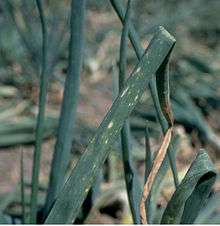Botrytis allii
| Botrytis allii | |
|---|---|
 | |
| Scientific classification | |
| Kingdom: | Fungi |
| Division: | Ascomycota |
| Class: | Leotiomycetes |
| Order: | Helotiales |
| Family: | Sclerotiniaceae |
| Genus: | Botrytis |
| Species: | B. allii |
| Binomial name | |
| Botrytis allii Munn (1917) | |
| Synonyms[1] | |
Botrytis allii is a plant pathogen, a fungus that causes neck rot in stored onions (Allium cepa) and related crops. Its teleomorph is unknown, but other species of Botrytis are anamorphs of Botryotinia species.[3][4] The species was first described scientifically by Mancel Thornton Munn in 1917.[1]
Biology
There are seven different species of Botrytis associated with onions in storage but the rot induced by B. allii and B. aclada causes the greatest commercial loss. The two can be distinguished microscopically; the conidia of B. allii have a maximum length of 15 μm and mean size of 10.2 × 5.7 μm, while the conidia of B. aclada have a maximum length of 12 μm and mean size of 8.6 × 4.6 μm. The infection is present in the field but does not manifest itself until after harvest, however there may be a falling off of vigour while the crop is still growing, particularly in cool, moist weather. In the stored crop, the rot typically starts in the neck of the bulb but can occur in other parts if there is physical injury.[4] The scales inside the bulb become progressively translucent and watery and a mycelium develops between them. A mass of grey conidiophores and conidia develop on the mycelium and blackish sclerotia form at the site of the initial infection.[4]
In onion crops grown for the production of seed, Botrytis allii can cause spotting and girdling of the stipe (stem) and develop on the sheath that protects the inflorescence and on the flowers themselves. Concentric grey rings may form as the fungus sporulates and the crop may lodge (become flattened).[4]
It has been shown that a major source of the pathogen is infected seed. In 1973, 71% of commercially available seed was found to be contaminated and the infection was found to persist for over three years in seeds being stored. In the seedling, infection with B. allii does not produce any symptoms, but the fungus spreads between plants as the conidiophores release spores into the air. The leaf tips are invaded first, the infection spreading down the leaves and into the neck of the bulb where its presence only becoming apparent when the foliage dies down at the end of the season.[5]
Hosts
Botrytis allii grows on Allium species including onion (A. cepa), aggregating onion (A. cepa var. aggregatum), shallot (A. cepa var. ascalonicum), garlic (A. sativum) and leek (A. porrum). It may also infect wild Allium species and can grow saprophytically on decaying crop residues such as cereal, pea and bean straw. It is capable of colonizing and producing spores on sterilized poppy straw (Papaver somniferum).[4]
Commercial importance
Botrytis allii is cosmopolitan in distribution and occurs wherever onions are grown. It is difficult to distinguish in the field between B. allii and B. aclada, but both are more common in temperate regions. Losses during onion storage from neck rot have been reported as being greater than 50% in some locations on occasion.[4]
References
- 1 2 "Botrytis allii Munn: 396, 1917". MycoBank. International Mycological Association. Retrieved 2013-03-31.
- ↑ Fresenius, G. (1850). Beiträge zur Mykologie (in German). Frankfurt, Germany: Heinrich Ludwig Brömmer Verlag. p. 16.
- ↑ "Botrytis allii Munn". Index Fungorum. CAB International. Retrieved 2013-03-30.
- 1 2 3 4 5 6 Chilvers, M. I.; du Toit, L. J. (2006). "Detection and Identification of Botrytis Species Associated with Neck Rot, Scape Blight, and Umbel Blight of Onion" (PDF). Plant Health Progress. doi:10.1094/PHP-2006-1127-01-DG.
- ↑ Maude, R. B.; Presly, A. H. (1977). "Neck rot (Botrytis allii) of bulb onions". Annals of Applied Biology. 86 (2): 163–180. doi:10.1111/j.1744-7348.1977.tb01829.x.